Together towards zero: Local health district's learnings and experience
Hunter New England, Australia.
Case study summary
Hunter New England Local Health District (HNELHD) will be carbon and waste neutral by 2030 as part of the ambitious initiative, Sustainable Healthcare: Together Towards Zero. We will be working hard over the coming years to achieve this green vision and take our place as an industry and community leader in sustainable health care.
Demographic information
- State/province/region: Hunter, New England and Lower Mid North Coast regions in New South Wales
- Country: Australia
- Type of institution: Public health service
- Number of full-time staff: 16,000+ staff, 1,600 volunteers
- Patient population served annually
- One million patients served annually (total of inpatient and outpatient)
- Geographic area served: 131,785 square kilometers, operates in 25 local government areas
- Top 1-3 health equity concerns experienced by the population: Access to health services for rural and regional communities, lack of regional health workforce to service the needs of the local communities, the highest Aboriginal and Torres Strait Islander population in NSW
- Number of beds: 3,419 beds across 28 hospitals, 42 community health service centers, and 12 multi-purpose service centers.
The issue
Health and environment are intertwined. 25% of all human diseases and death in the world is attributed to environmental factors including extreme heat, drought, poor quality air and natural disasters. It is estimated that children will suffer more than 80% of the illnesses, injuries and deaths attributed to climate change.
Health care contributes 7% of total CO2 emissions in Australia higher than the global average of 5% from the health care sector. As a health care provider we have a significant impact on the environment through the generation of our hazardous waste, high consumption of resources, and high energy use. Because of this and the impact it has on our community and patients Planetary Health is now part of our core business. Through the promotion of our sustainable health care practices, we can mitigate the negative impacts of environmental degradation on public health, contributing to a healthier planet.
Climate change is affecting the Hunter New England (HNE) region, particularly through increasing temperatures. Projections show temperatures are expected to keep rising, rainfall patterns will change, there will be more hot days and heatwaves and fire weather will increase. The impacts of this can be seen through recent prolonged drought and the widespread bushfires of 2019–2020, which burned properties and farmland right across the region.
These reoccurring events impact on our service delivery. Vulnerable people’s medical conditions worsen, leading to possible loss of life, our emergency presentation’s increase, including a surge in paramedic services.
Hospital goal
As the largest Local Health District in New South Wales, we saw an opportunity to make impactful changes to the way we operate and be a leading example to the sector. Identifying low, medium and high carbon abatement ambition scenarios and adapting the principles below (figure 1) we calculated a baseline greenhouse gas (GHG) emissions inventory, comprised of Scope 1, 2 and material Scope 3 emissions. We need to move from 97,059tCO2-e to 0tCO2-e in 10 years.

Our aims are as follows:
- To develop a whole-district carbon and waste-neutral strategy.
- Empower every individual across this large, complex health system to feel they contribute to achieving the strategy.
- As the biggest employer in the region, we want to drive change in the market and display public leadership while creating a movement of sustainability.
Sustainability strategy implemented
Working with the New South Wales (NSW) government, we plan to build a climate-resilient health system, adapt to climate change by enabling regional adaptation, and embed our sustainability strategy across the organization.
SDG’s and NSW’s net-zero plan served as a public framework to guide engagement at all levels, enabling us to gain the buy-in and commitment we were hoping to achieve. The plan was developed in consultation with the former board chair, chief executive, and executive director along with other key stakeholders.
Our Sustainable Health Care: Together Towards Zero strategy is sector transforming. It outlines our commitment to achieve carbon and waste neutrality by 2030, a first for any local health district (LHD) in NSW. The strategy focuses on six areas: energy, waste, water, transport, procurement, and infrastructure, with 2030 targets including:
- Zero electricity from non-renewable sources. Reducing by 10% per annum from baseline 100,000 MWh.
- Zero general waste to landfill. Reducing by 10% p.a from 3,400-ton baseline.
- Decreasing water consumption by 50% from water utilities.
- Rainwater captured and reused at all HNE facilities.
- Capturing and reusing water in all renal dialysis sites, with potential savings of more than 30 million liters across the district.
- Zero CO₂ from HNE Health fleet vehicles.
- Adopting procurement standard ISO24000.
- New buildings meet a minimum five green star rating.
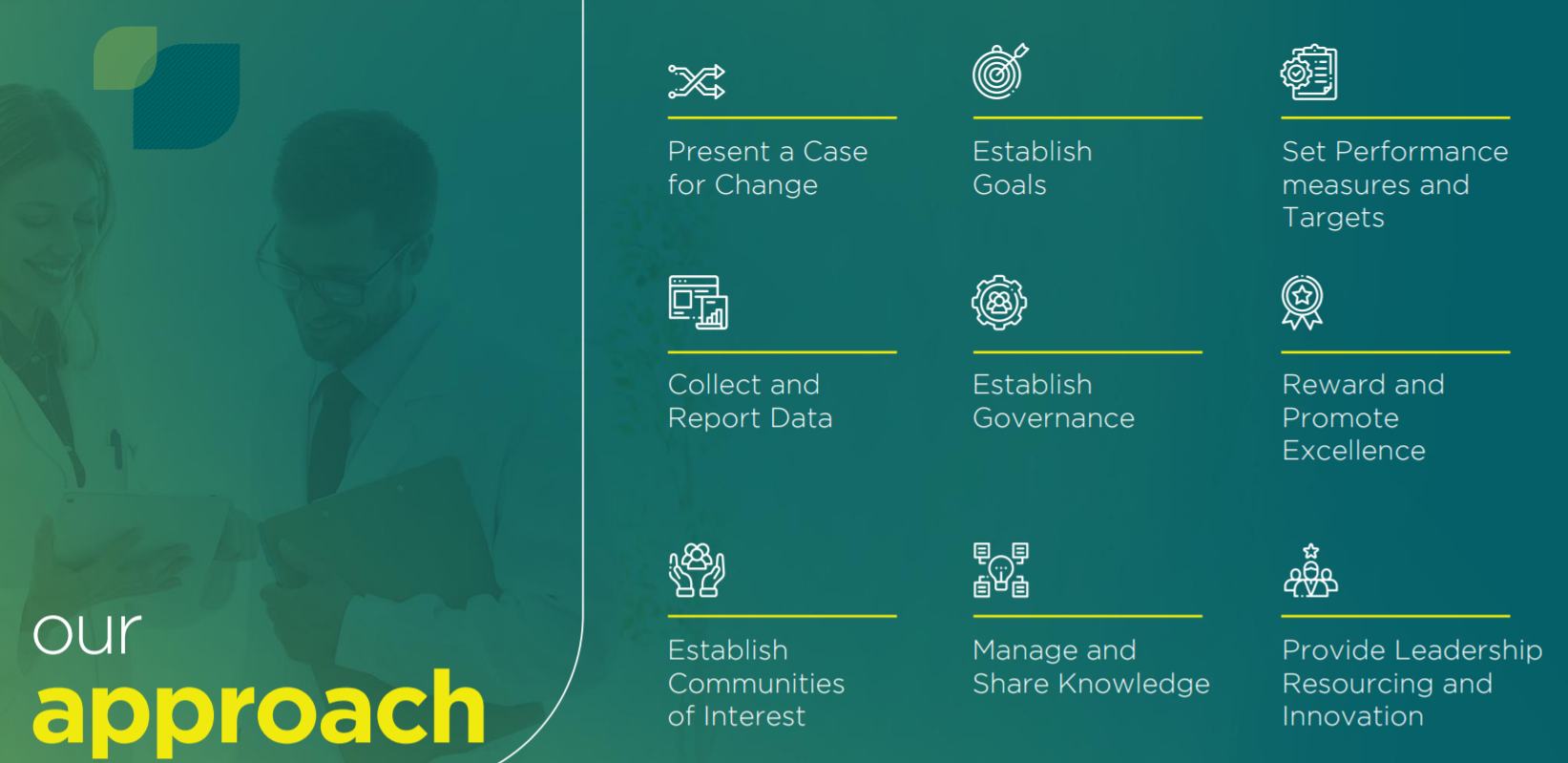
Present a case for change: Our case for change was endorsed by the board in 2021, which lead to the launch of the strategy across our team and the community including:
- Board chair featured in the chief executive newsletter on the importance of the sustainability strategy.
- Highlighting our trajectory through the strategy video.
- Launching the strategy to 180 sustainability champions, hosted by Dr. Ramsey Awad, executive director of infrastructure, planning and sustainability.
- Sustainability and strategy have a dedicated page on our website.
- The strategy and net-zero projects feature on our Facebook channel.
- Received media coverage in local papers, TV, and trade publications.

Established goals: We have established ambitious goals to stimulate innovation, positive engagement, and improved environmental performance.
- Acknowledge and advocate for the connection between human health and the environment.
- Eliminate our contribution to the burden of disease and work towards reducing our environmental impact while being fiscally responsible.
- Adopt Aboriginal stewardship values for our environment and caring for the country.
- Engage and empower our staff and community to participate in this journey of sustainability transformation.
- Contribute to leading a movement of sustainability.

It’s very exciting to be part of a strategy that is so ambitious and future thinking. It inspires us as healthcare workers to play our part in helping our district to achieve the goals we’ve set out.
Set performance measure and targets: In conjunction with the NSW government, we committed to achieving net-zero emissions by 2050. Our performance measures and targets have been determined through our carbon footprinting exercise and our 2020 baseline inventory.
Collect and report data: Data is collated systematically from suppliers, reporting the organization's sustainability performance. Through the data, we track progress towards our goals and ensure that we are meeting our commitments while holding ourselves and others key stakeholders accountable. Presenting data in a clear and compelling way, we can help stakeholders understand the issues and make informed decisions.
Established governance: Embedding the strategy into daily operations continues, with departments delivering on targets that are measured and reported regularly to the board.
Sustainability is overseen by the board and increasingly integrated across several formal board subcommittees, helping demonstrate corporate commitment to sustainability at the highest level. Sustainability is sponsored by the executive leadership team and directed by Dr. Awad. Engaged leadership across business units, regions, and services provides further oversight and strategic guidance allowing employees to implement strategies.
The implementation of the sustainability strategy is led by a program manager and supported by a core team integrating sustainability across the district and implementing organization-wide initiatives.
Reward and promote excellence: Our Hunter New England Health Excellence Awards recognize innovative and sustainable health programs that deliver meaningful outcomes to patients and invest in the wellness of our community. They celebrate the pinnacle of clinical excellence, quality, innovation/improvement, and outstanding achievement across the district.
Establishing community of interest: We have established a robust stakeholder engagement plan to tackle the sustainability challenges facing us. Key external stakeholders we regularly engage are:
- Global Green and Healthy Hospitals
- National Sustainable Healthcare Network
- Doctors for the Environment
- NSW Department of Planning, Industry, and Environment
- Circular Australia
- Local councils through the Hunter Joint Organization
- University of Newcastle
Manage and share knowledge: We as an organization can lead sustainable change and co-create an environment that supports individual change. The individual can then create a chain reaction to stimulate change within their environment. It is our goal to lead a movement of sustainability by engaging and empowering our staff and community to participate. This journey of sustainability transformation is our legacy.
We have established a community of interest with more than 200 staff committed to our sustainability champions program. These passionate and willing champions invest time and energy to help us achieve our goals and bring clinically focused staff together with researchers, funders, and project managers to reimagine their services with a net-zero lens. Through these established net-zero teams within specific clinical areas, sustainability champions lead delivery and engagement and share their learnings. We're pleased this strategy is creating discussion and encouraging staff to offer their ideas, bringing us one step closer to green health care.
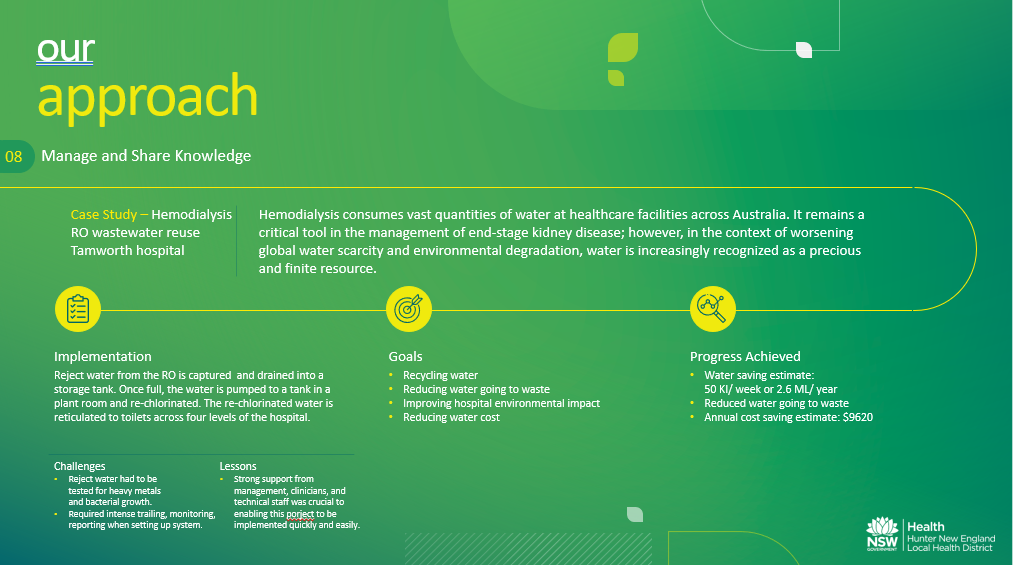
Provide leadership resourcing and innovation: Providing resources ensures our sustainability leaders are equipped with the best up-to-date information to drive sustainability into policies, practice, and behaviors. Getting to a net-zero health system will require changes and innovations across every service and specialty. Here at Hunter New England Health we have established net-zero leads in surgical services, allied health, and imaging which supports, connects, and inspires our staff to rethink and reimagine their services with a net-zero lens.
Our leadership is displayed through invitations to present at and attend conferences including:
- UK Government COP26 Health Initiative – Roundtable for Australian Health Ministers
- ACHSM – Climate change: Leading in an Uncertain Future
- HEAL (Healthy Environments And Lives) Conference
- Doctors for the Environment
- Women’s and Children's Healthcare Australasia
In 2022 we proudly co-hosted the Greening the Healthcare Sector conference with Climate and Health Alliance and Global Green and Healthy Hospitals Network with more than 300 participants across Australia and New Zealand.
Beyond attending and presenting at multiple conferences annually, the sustainability leadership team was invited to participate in the Cambridge University sustainability practitioner and executive Program, which focuses on the relationship between the three dimensions of sustainability: society, environment, and economy.
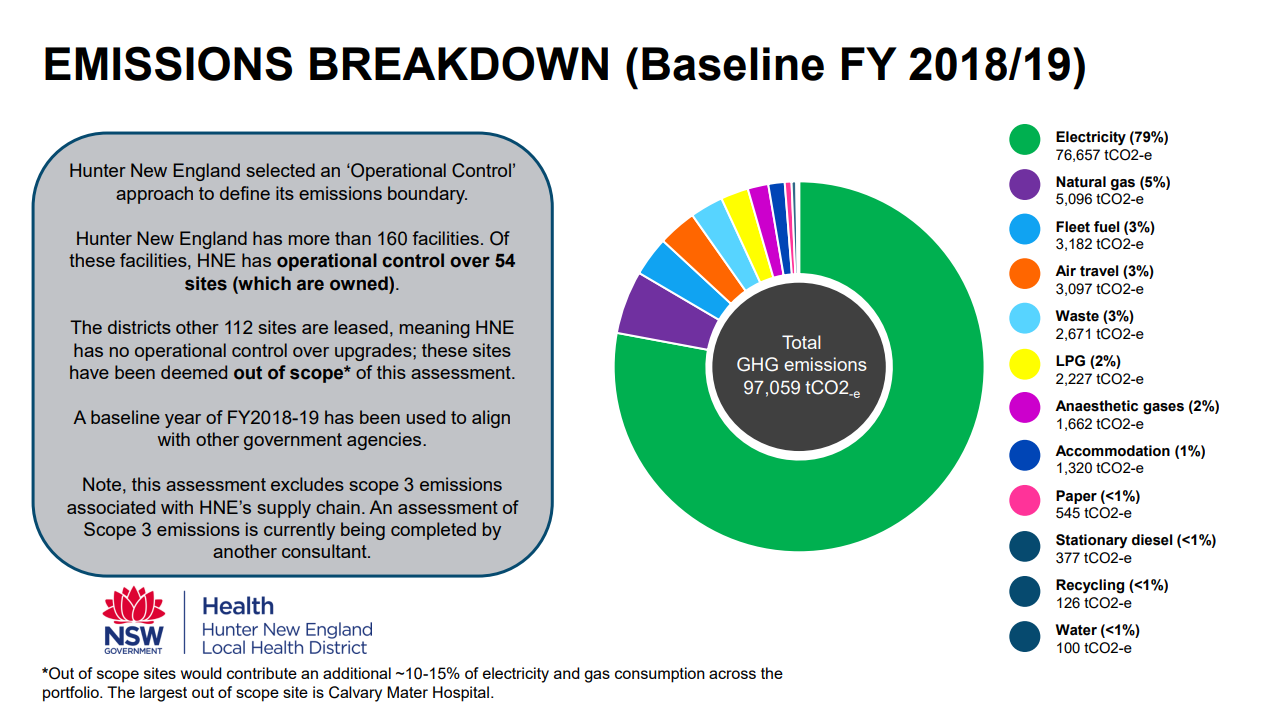
Tracking progress: The organizational and operational boundary of the local health department was assessed in collaboration with consultancy team 2XE, where 2XE and agency stakeholders conducted an emissions boundary relevancy test (based on Climate Active carbon neutral standards) to confirm which scope 1, 2, and 3 emissions sources will be included in the agency’s organizational boundary. Recognized quantification methodologies, such as those detailed in the Climate Active standard, national greenhouse accounts factors and GHG Protocol standards, were used to process and convert the data and provide a complete greenhouse gas emissions inventory. This inventory will enable categorization of emissions by:
- Emissions source (electricity, natural gas, transport)
- Scope
- Asset type
Our dashboards are built and maintained in-house by a data analyst who oversees the collection, storage, and analysis of the data that powers these dashboards. The data is regularly collected from our suppliers or the relevant parties and stored in a Microsoft Dataverse database. Power Bi is used to design dynamic dashboards, which manipulate and visualize this collected data.
We investigated other data management solutions but found our internal system to be the best suited, as it allows for reliable design and more control over how the data is analyzed and displayed.
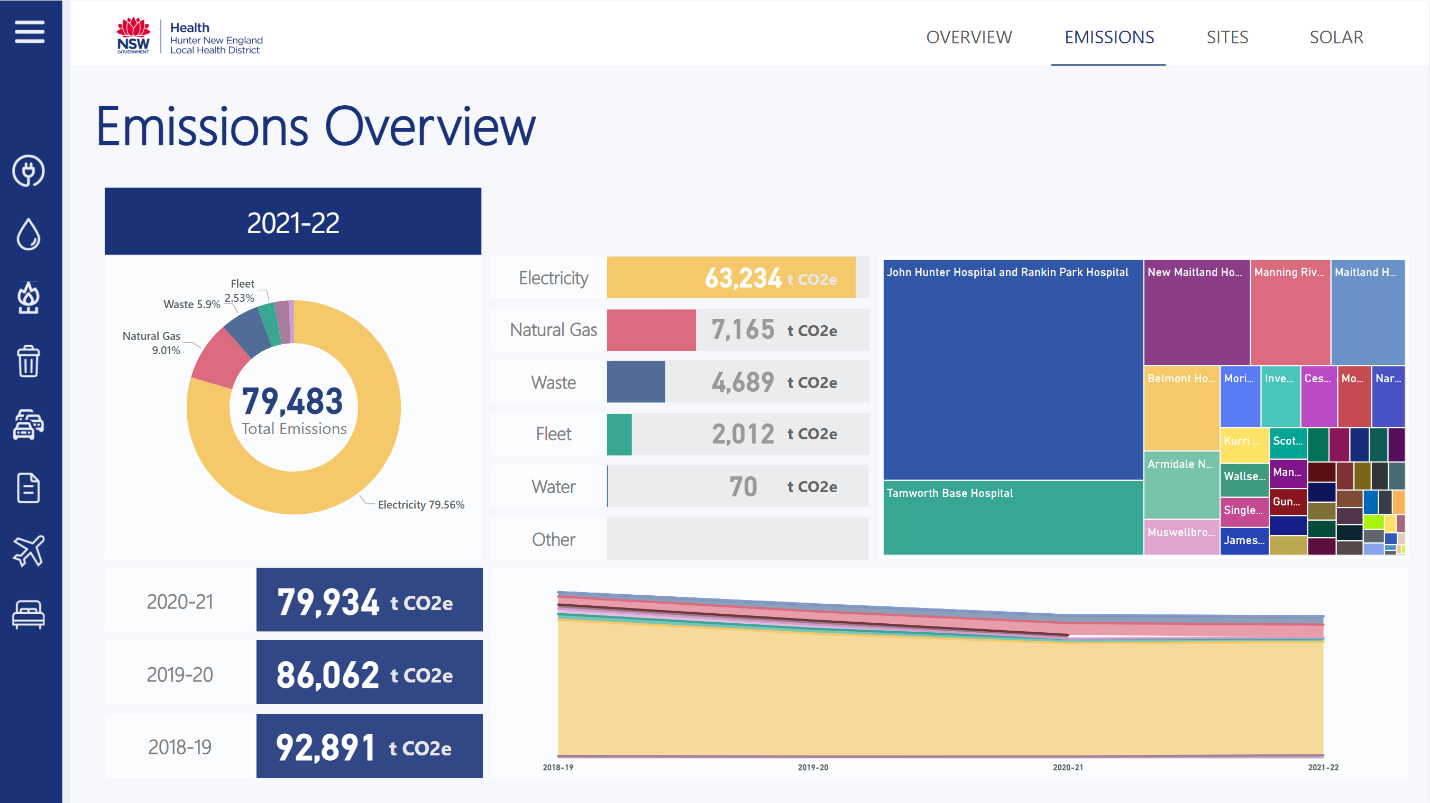

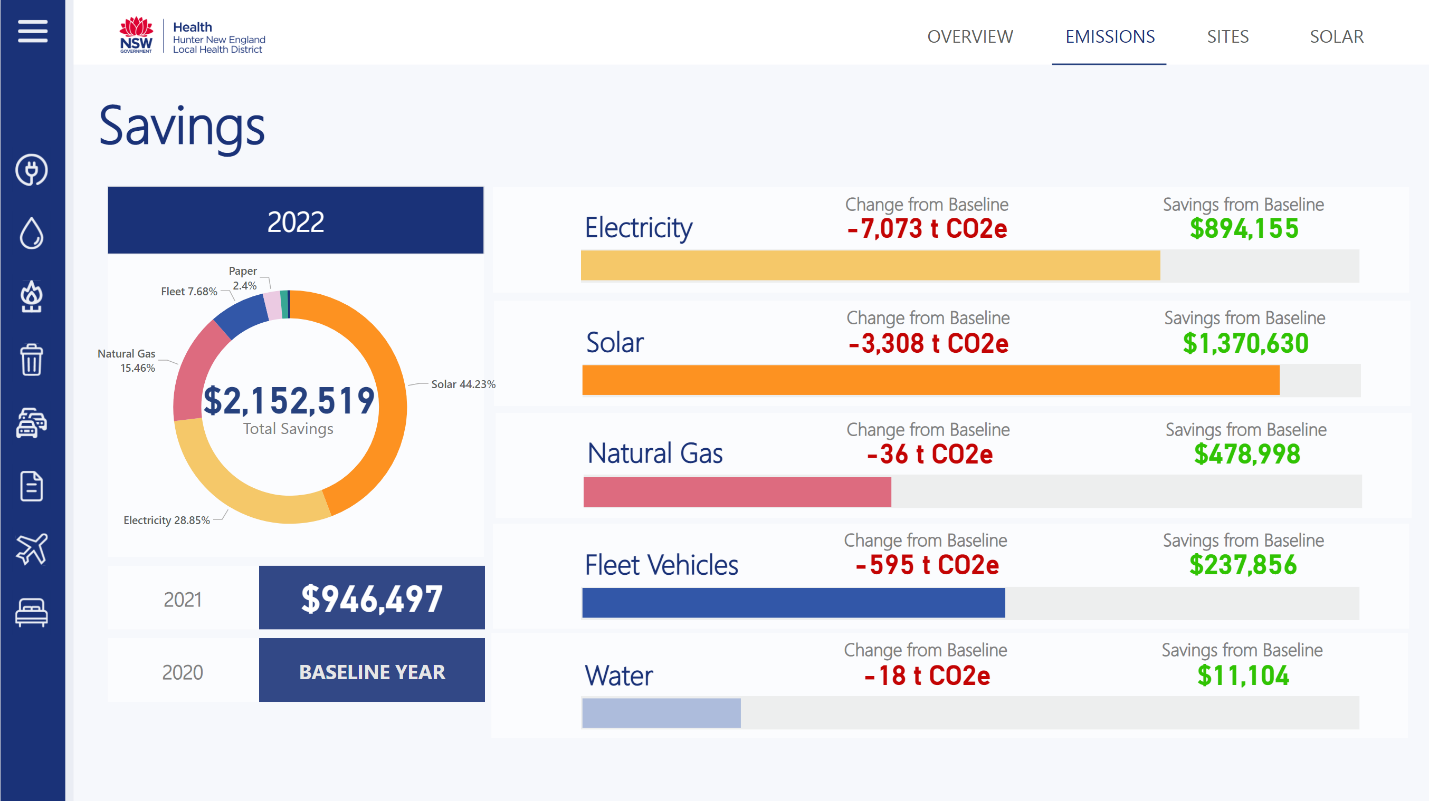

Most clinicians are astutely aware of the complex interplay between the environment and health outcomes. For many years, "going green" was not deemed to be the core business of the health service and efforts to make sustainable changes were often overlooked. The implementation of the Sustainable Healthcare: Together Towards Zero strategy shifted the narrative and justified the importance of delivering sustainable healthcare across the organisation.
Progress achieved
- Largest hospital solar installation – SDG 7: John Hunter Hospital has the largest solar panel installation of any hospital in the world. The 2.4 MW system will generate 3,328,200 kWh per annum, abating our carbon emissions by 2,700 tons annually.
- Recycling renal dialysis byproducts – SDG 6: Clean, excess water produced as a byproduct of renal dialysis is being put to good use at Tamworth Hospital. The $15,000 investment reduced water usage by 46%, saving the hospital 2.5M liters of water.
- Reducing desflurane by 71% – SDG13: HNELHD has reduced use of desflurane by 71%, saving 10 tons of CO₂ and approximately $1M per year without compromising patient care.
- Recycled roads and carparks – SDG 9 and 12: The New Maitland Hospital development is the first in NSW to utilize the high-recycled-content asphalt Reconophalt.
- We acknowledge the values of environmental Aboriginal stewardship and have developed and maintained a collaborative relationship with local Aboriginal and Torres Strait Islander people.
Challenges and lessons learned
Identifying a net-zero emissions pathway for a complex, highly specialized, large health care system is particularly challenging. It is important to recognize that while we have been able to model our emissions reduction roadmap focusing predominantly on scopes 1 and 2, 60% of a health system’s carbon footprint is from clinical care supply chain, pharmaceuticals, medical devices and equipment, anaesthetic gases, and respiratory inhalers. It will be vital to address scope 3, potentially our greatest opportunity, if we are to meet our goals.
The goals and feedback on the goals should follow a system cascading down the levels of the organization.
Next steps
Built forms: HNE can reduce emissions by 28% through cost-effective efficiency projects, building envelope upgrades, electrification of gas hot water systems, and intelligent sustainable design.
Transportation: Forty-five percent of our fleet travel less than 5,000km each year and could be removed from the fleet or transitioned to electric alternatives.
New models of patient care: Working with clinicians to undertake a holistic review of current models of care with sustainability in mind, the LHD can transition to more effective and sustainable practices.
Circular resources: Waste emissions can be reduced by minimizing the amount of waste generated during operations by actively procuring low-waste goods and recycling materials for use in new products.
Carbon sinks and climate resilience: The predominant risk to the HNE community is increased temperature and heat waves, which can be mitigated through sustainable design, planning, and the greening of infrastructure.